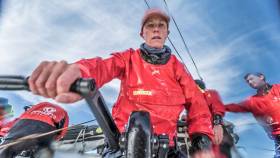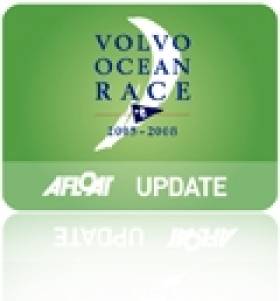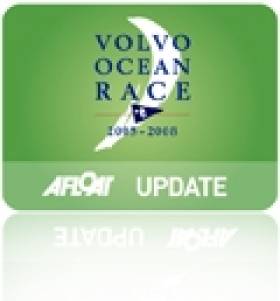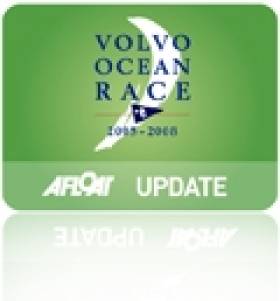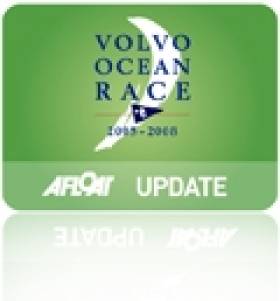Displaying items by tag: Dongfeng
Women Join Dongfeng Crew For 2017-18 Volvo Ocean Race
#VOR - Dongfeng Race Team has announced two women for its crew as preparations ramp up for the 2017-18 Volvo Ocean Race.
Dutch Olympic sailor Carolijn Brouwer, who competed in the previous VOR with the all-female Team SCA, will be joined by France’s Marie Riou, a fellow Olympian and a multi-time Nacra 17 world champion.
They will sail alongside previously announced crew members Jérémie Beyou, Stu Bannatyne and Daryl Wislang under returning skipper Charles Caudrelier for the Chinese entry that secured third place in its first VOR in 2014-15.
Caudrelier said Brouwer was a given for his crew “because she beat us many times during the last race when she helmed Team SCA in the in-port races.
“We all knew that she is a good helm and she has a big Olympic past and I really respect that. But her Olympic campaigns have turned her into a very fast driver and she knows where to put the boat.”
Riou, meanwhile, brings a wealth of Olympic sailing and offshore racing experience to the team, along with her strength and “good spirit”, the skipper added.
Brouwer and Riou’s selection marks the first move under last year’s rule change to encourage mixed crews in the next edition of the race, as previously reported on Afloat.ie.
It’s not the only first for Dongfeng, which last month released footage of its refitted Volvo Ocean 65 in testing off Lisbon — where the race fleet is being readied at the VOR’s Boatyard facility ahead of the race start in seven months’ time.
An eighth boat is in the final stages of construction at Persico Marine in Italy for new campaign Team AkzoNobel.
Dongfeng VOR Leaders Bow Out of Southern Ocean
#vor – Dongfeng Race Team with Ireland's Damian Foxall onboard announced late last night that they plan to retire from Leg 5 of the Volvo Ocean Race after breaking their mast in the Southern Ocean. Skipper Charles Caudrelier had considered attempting to re-join the 6,776-nautical mile stage from Auckland to Itajaí after successfully nursing Dongfeng to Ushuaia, Argentina, earlier in the day.
But on Tuesday night, a statement from the team read: "The decision has been made to motor-sail to Itajaí and not rejoin the race – although skipper Caudrelier has yet to officially retire from the leg at this time, it is just a matter of protocol now.
"He will not relish this part of the administrative process and if there had been any other timely and effective way to rejoin the race and get to Brazil, he would have undoubtedly taken it.
"But even under motor-sail the delivery trip is expected to take around 10-12 days and then add the days needed to refit the boat in time for the start of Leg 6 to Newport.
"Trying to rejoin the race which would mean returning to the point they started using the engine at the western entrance of the (Beagle) Channel then sail south around Cape Horn would prove to be too risky, especially with rig and sails not fully fit for racing.
"It wasn't safe to enter the Beagle Channel without the engine, even if it would have left more options for a racing departure."
By motoring to Itajaí, they will buy some time to make the repairs ready to start Leg 6 to Newport - although it will still be tight. The fleet is due to depart on April 19.
Dongfeng Race Team plan to leave Ushuaia for Itajaí on Wednesday evening.
At 0315 on Monday, a sickening crack had signaled to Caudrelier and his crew that the top section of the mast had fractured, leaving the boat without full manoueverability.
The decision means that Dongfeng Race Team, who were joint leaders with Abu Dhabi Ocean Racing (Ian Walker/GBR) at the start of the leg, will collect eight points for a Did Not Finish result.
In the latest position report at 1840 UTC on Tuesday, Abu Dhabi Ocean Racing led by 8.8nm from Cape Horn pace-setters, Team Alvimedica (Charlie Enright/USA)
#vor – New dramatic footage of Damian Foxall's stricken Volvo Ocean Race men on the dismasted Dongfeng has emerged with crew man Kevin Escoffier up the mast cutting away the damage as the crew make the necessary sacrifices to stabilise the situation working to secure the mast before entering the Beagle Channel. There's frustration in the Southern Ocean for the Chinese team as Escoffier breaks his grinder while cutting the sail free and as darkness falls it's a race against time for the determined men of Dongfeng.
For the professional offshore sailors of the world, mast breakages (or any sort of damage to the boat) is an unfortunate occupational hazard. That's not to downplay the devastation and disappointment of what happened but for sailors like Damian Foxall, Charles Caudrelier, Martin Strömberg and even Pascal Bidégorry, dismasting in the Southern Ocean is an unfortunate case of déjà vu. These men have been there and done that.
For our rookie Chinese sailors on the other hand, the experience has been shocking, scary and bewildering. The reaction of Liu Xue (Black) is understandably in contrast to the pro crew who know how to manage these kinds of situations. Seen through his eyes, it is a heart wrenching reaction...
Liu Xue (Black): "Speechless, really speechless, I still can't believe this is true. You know one day, only one day we will have passed Cape Horn. Just one step and my dream will have come true, what a shame!"
"I thought a lot when the accident happened. What I wanted to do the most is to let my family to know that I'm safe. Because as the race is going and with more and more media coverage going out, my family started to know more about this leg. My mom was concerned about my safety a lot at some point. Actually there's nothing special, I know that I wouldn't be able to speak with them, I just would like them to know that I'm all good, that's it.
"I was sleeping below when the accident happened, I was shocked when I came on the deck. I have the feeling all the time that this is like in a movie. The 'scenes' of this leg is been played quickly in my brain. I'm not reconciled at all – the team worked closely and we fought so hard. And it's all gone in no time. Nothing left. We were only 240nm and 10 hours away from realising the dream.
"In this short 10 minutes, my dream has been crushed. We've been through so many suffering days before, we fought so hard just for this.
"Our skipper is surprisingly calm this time. He's too calm, we don't even have the feeling that he's just been through such frustration. Probably it's because he has his old mates Pascal, Damian and Martin onboard, and (their presence) gives him energy.
"The presence of Damian is the key of solving this problem. Because he's there, we were not in a panic. His makes us feel confident.
"Pascal is like a kind father this time. He came and touched Wolf's head and my head, comforting us 'it's going to be ok, we still have chance and time'. He even made a joke with me. He told me when he attempted to sail around the Cape Horn 14 years ago, the mast was also broken, and it took them 22 days to reach the Cape Horn after the damage happened, so we are actually lucky this time.
"Everyone's reaction after what happened made me feel warm and touched. Actually I didn't cry, I was just sad. But I wouldn't feel ashamed even if I cry, because the journey of this leg is marvellous. We are learning something new about the ocean every day, we respect the ocean, and also looking forward for the next challenge.
At the beginning of this project, managing expectations of our Chinese sponsors was key. This is ocean racing, something will happen, we have some very inexperienced sailors onboard we must take precautions. Then naturally when something like this happens, telling our partners is not easy. But the support from our partners has been outstanding and demonstrates their appreciation of what taking on the Volvo Ocean Race really means.
"We are sad to know the failure of the mast but happy to know all the team are safe. Please let Charles and his team know we are always with them, safety first, then try to repair the boat and get ready for next fighting!" Gary Huang, Vice President of Dongfeng Trucks.
Dongfeng Dismasted in Volvo Ocean Race
#vor – Damian Foxall's Dongfeng Race Team has broken its mast early this morning in the Southern Ocean leg of the Volvo Ocean Race. Reports from onboard the yacht say nobody has been injured and there is no immediate danger to the crew.
The incident happened 240 nautical miles west of Cape Horn at 0315 UTC on Monday, in the final hours of the night onboard Dongfeng.
The crew reported that the mast broke above the third spreader. They are not planning to continue racing on this leg and are heading towards Ushuaia, Argentina, under their own sail.
Reached via Inmarsat, a disappointed Caudrelier said "I'm gutted. As you've seen from the position reports we have been on purpose backed off a bit, not attacking in any way. The mast broke without warning, in about 30 knots of wind. We are unable to sail safely on starboard tack, but we are able to make reasonable speed on port tack. We will head towards Ushuaia and assess our options for getting to Itajai"
The Maritime Rescue Coordination Centre (MRCC) is aware of the situation and is on standby to help if necessary.
The mast remains quite unstable on Dongfeng as Damian Foxall explains: "We really cannot do much more to stabilize the situation right now. At some stage I think we are going to have to go up there and cut some stuff off."
Following the breakage of the mast onboard Dongfeng at 0315 UTC today (Monday, 30 March), the determined men of Dongfeng are now sailing slowly towards Ushuaia, Argentina, itself 250 miles away. The entrance to the Beagle Channel that leads there is just 160 miles away, then another 70 miles in the channel. The crew are able to continue sailing using a small headsail only, and only on port tack for now, progressing at a speed of around 6-8 knots [very rough ETA Ushuaia if all goes well will be midnight GMT tomorrow]. The Dongfeng shore team have been scrambled and are already on route to rendezvous with the boat. The Volvo Ocean Race technical support team, headed up by Nick Bice, along with GAC, are already on the logistics of getting one of the spare masts to Brazil.
Charles describes what happened:
"I was inside, we were sailing along and suddenly I heard a bang – I thought it was a rudder – the guys on deck called everyone on deck. First thing I imagine was that the top car of the mainsail had broken, we didn't realise the mast was broken at first. Then we came outside and we realised. It was a dark night and we put the light on the top of mast and the mast was broken over the top of the third spreader – end of the leg, maybe."
Why?
"We were not pushing a lot, less than the others, as I really wanted to take care of the boat. We have to find out why; we have a few ideas – it doesn't seem like we broke a cable (rigging), more like the mast tube break itself. Why? We don't know. We will have to solve this with Southern Spars but it's too early to speak about that."
Difficult conditions?
"We didn't make any mistake, we were sailing normally, not in really strong conditions – fast conditions, for sure. The sea state was quite good and could not have been a reason."
The impact on Dongfeng's race?
"We are going to lose a lot of points. It's not ideal for us. We are going to have hard moments – instead of racing for the next 7 days we will be trying to solve this problem and to join the next leg so we are going to be very busy. Not much rest so it's going to be a hard time for the team. I always tell to my guys, you don't do the Volvo Ocean Race without meeting a BIG problem. Last time (on Groupama), we broke the mast on the same leg and we won the race so the game is not over for us. We will lose some points but we will still be on the podium and we are going to attack and try to come back. It's not the end of the world, just one leg hopefully."
Is it safe onboard right now?
"Yes, but we have 4-5 metres of the mast flying over our heads just holding on by one halyard and the big fractional sail, the one we had up, which is flying around to leeward. We have to solve this problem as we cannot go to Ushuaia like that – that is my main concern now. Maybe we have to abandon the whole rig but I hope not. I'm not sure we can save our mainsail so this is what we will focus on in the next hours."
The dilemma:
Dongfeng has not officially retired from leg 5 as yet and skipper, Charles Caudrelier, is still considering the possibility of the race crew continuing on from Ushuaia under sail once the rig has been fully stabilised and the boat checked, to sail back west and around Cape Horn and on to the finish in Itajai. Finishing the leg in last place will score 6 points, a DNF (Did Not Finish) following an official retirement, scores 8 points. Only 2 points difference but 2 points that could make all the world of difference by the time this nine-leg race finishes in Gothenburg in June (NB lowest cumulative points wins).
The reality of that undertaking for the crew is considerable – reaching Itajai days after the rest of the fleet and having less time for crew to recover, and for boat to be refitted – is also a concern. Alternatively, the shore team can get the boat to Itajai under engine and carry out maintenance work en route ahead of the full repairs required once they reach Itajai. This is the dilemma for the skipper, but Charles and the team management will be considering all the options fully before making a final decision and we know although Charles is competitive, he puts the safety of his crew first.

The mast broke above the third spreader. We are not planning to continue racing on this leg and are heading towards Ushuaia, Argentina.
— Dongfeng Race Team (@DongfengRacing) March 30, 2015
Dongfeng Win VOR Leg Three, Leading All the Way from Abu Dhabi to Sanya
#vor – It was an unbelievable end to a magnificent Volvo Ocean Race leg for Dongfeng Race Team. After leading the fleet virtually all the way from Abu Dhabi to Sanya in China, over more than 5,000 miles of intense ocean racing, Dongfeng finally crossed the finish line in first place as the sun rose over Sanya (23:31:38 UTC) in a time of 23 days, 13 hours, 31 minutes and 38 seconds.
This is the first time in history a Chinese team (or any Chinese sailor) has won a leg in the Volvo Ocean Race's 41-year history. And what a leg to win supported by its Chinese partners – Dong Feng meaning wind from the east, Aeolus (Fong Shen) meaning the Wind Guardian and the City of Shiyan.
The reality is that it couldn't have been scripted better. The Chinese team with two Chinese rookie sailors onboard – Liu Xue (Black) and Cheng Ying Kit – showed unparalleled grit and determination and led the entire fleet of some of the world's best offshore sailors to their home country China. With the ambition to 'bring offshore sailing to China' nobody could have predicted the impact this team would have.
Arriving at the pontoon in Serenity Marina, Charles Caudrelier said: "It was the most stressful race of my life. We take the lead on the first day and we had to keep it because we had to arrive first here because it was very important for me and for the project, so we are so proud. One year ago we were here and we were discovering the Chinese sailors who were rookies and now they win the leg – it's just fantastic. Maybe in the first time in offshore sailing something like this has happened – in just one year these guys have become great sailors. I am so proud, this is everything I wanted but I didn't dare think about. It's a team job and you cannot win a leg without a strong team."
There were moments of panic where the chasing pack were catching up and the lead did diminish (from 106 miles to 9 miles at one point). In just under 24 days and racing more than 5,000 nautical miles, Dongfeng held their position. It's the longest time any team has led the fleet since the start of the race back in Alicante in October, which is no surprise as the determination onboard Dongfeng was almost tangible as the teams left for Sanya. Dongfeng was going to fight like hell to win this leg.
Persian Gulf, Hormuz Strait, Gulf of Oman, Arabian Sea, Bay of Bengal, Andaman Sea/Malacca Straits and the South China Sea are just a few of the challenges the determined men of Dongfeng have had to face as they battled their way through leg 3. Dongfeng have shown exceptional capabilities and stamina on what has been one of the slowest and agonizing legs so far.
This is the ultimate triumph for a project that has the future of Chinese sailing at its core. The youngest sailor in the race at the age of 21, Liu Xue, could not contain his delight on the dockside: "I have made the best decision of my life to join this team. I have learnt so much. This leg and this moment I will remember and cherish for the rest of my life." As a very proud grandmother, who had never flown on a plane until she flew into Sanya for this arrival, stood close by to Black.
When it was agreed that Dongfeng Race Team would lay the foundations for offshore sailing in China no one could have predicted such a perfect result. With little under a year of training the Chinese sailors in the squad have impressed, even if this made Dongfeng Race Team one of the less experienced teams and, subsequently, the least favourite to win when the race started. So this is not only a victory for China but for Caudrelier and his men who have worked day and night to train their Chinese counterparts.
Charles Caudrelier wrote on day 12 of the leg: "I am watching them with admiration, we're leading this leg, we're at the top of the overall leaderboard – you can't compete with the race favourites without a great team. And to build a great team, you need great players. Thinking about the journey of the Chinese sailors since February 2014, Black didn't speak a word of English and had never spent a night at sea. But from the first day he really impressed us – then he quit straight away after his first offshore sailing, beaten by the brutality of the bad weather – and then a few months later he returned. To start your offshore sailing career with a Volvo Ocean Race is brutal. This afternoon I was watching him trim the sails and I realised that he's learnt thousands of details in a very short period of time. It's the same for Kit who is realising his life's dream onboard right now, his first offshore race. This evening he gave me a Chinese lesson, and it reinforced the enormity of the challenge they [the Chinese sailors] are taking on, learning in 6 months to sail and to work in a previously unknown language. I am proud of them."
The Vice President of the International Sailing Federation and China Yachting Association, Mr. Li Quanhai congratulated to Dongfeng Race Team on their victory and stated: "Dongfeng Race Team has made history. It is the best result for a Chinese team in the world of offshore sailing."
Dongfeng Race Team has delivered an outstanding result on this leg and is going to enjoy the moment! However, even though this victory has put Dongfeng at the top of the overall leaderboard, this is only leg 3 of 9 and we can only be as good as our NEXT result.
Dongfeng Race Crew Leg 3:
Charles Caudrelier, Skipper (FRA)
Pascal Bidegorry, Navigator (FRA)
Cheng Ying Kit (Kit) (CHN)
Liu Xue (Black) (CHN)
Thomas Rouxell (FRA)
Kevin Escoffier (FRA)
Eric Peron (FRA)
Jack Bouttell (ENG/AUS)
Sam Greenfield, Onboard Reporter




























